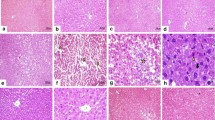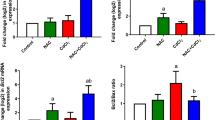Abstract
The aim of the present study is to evaluate the protective effect of manganese chloride against carbon tetrachloride (CCl4)-induced liver injury in rats. Manganese chloride (0.001, 0.01, 0.05 and 0.1 g/kg bw) was administered intragastrically for 28 consecutive days to male CCl4-treated rats. The hepatoprotective activity was assessed using various biochemical parameters such as alanine aminotransferase (ALT), aspartate aminotransferase (AST), alkaline phosphatase (ALP), γ-glutamyltransferase (GGT) and superoxide dismutase (SOD). Histopathological changes in the liver of different groups were also studied. Administration of CCl4 increased the serum ALT, AST, ALP and GGT but decreased SOD levels in rats. Treatment with manganese chloride significantly attenuated these changes to nearly normal levels. The animals treated with manganese chloride have shown decreased necrotic zones and hepatocellular degeneration when compared to the liver exposed to CCl4 intoxication alone. Thus, the histopathalogical studies also supported the protective effect of manganese chloride. Therefore, the results of this study suggest that manganese chloride exerts hepatoprotection via promoting antioxidative properties against CCl4-induced oxidative liver damage.


Similar content being viewed by others
References
Crossgrove J, Zheng W (2004) Manganese toxicity upon overexposure. NMR Biomed 17:544–553
Ashner M, Vrana KE, Zheng W (1999) Manganese uptake and distribution in the central nervous system (CNS). Neurotoxicology 20:173–180
Wedler FC (1994) Biochemical and nutritional role of manganese: an overview. In: Kllimis-Tavantzis DJ (ed) Manganese in health and disease. CRC press, BocaRaton
Korc M (1988) Manganese homeostasis in humans and its role in disease states. In: Korc M (ed) Essential and toxic trace elements in human health and disease. Alan R. Liss, New York, pp 253–273
Dickerson RN (2001) Manganese intoxication and parenteral nutrition. Nutrition 17:689–693
Hsieh C, Liang S, Peng SS, Lee W (2007) Seizure associated with total parenteral nutrition-related hypermanganesemia. Pediatr Neurol 36:181–183
Gonzalez-Reyes RE, Gutierez-Alvarez AM, Moreno CB (2007) Manganese and epilepsy: a systematic review of the literature. Brain Res Rev 53:332–336
Drown DB, Oberg SG, Sharma RP (1986) Pulmonary clearance of soluble and insoluble forms of manganese. J Toxicol Environ Health 17:201–212
Dorman DC, Struve MF, James RA, Marshall MW, Parkinson CU, Wong BA (2001) Influence of particle solubility on the delivery of inhaled manganese to the rat brain: manganese sulfate and manganese tetroxide pharmacokinetics following repeated (14-day) exposure. Toxicol Appl Pharmacol 170:79–87
Kumar SS, Kumar BR, Mohan GK (2009) Hepatoprotective effect of Trichosanthes cucumerina Var cucumerina L. on carbon tetrachloride induced liver damage in rats. J Ethnopharmacol 123:347–350
Marina N (2006) Hepatotoxicity of antiretrovirals: Incidence, mechanisms and management. J Hepatol 44:S132–S139
Baranisrinivasan P, Elumalai EK, Sivakumar C, Viviyan Therasa S, David E (2009) Hepatoprotective effect of Enicostemma littorale blume and Eclipta alba during ethanol induced oxidative stress in albino rats. Int J Pharmacol 5:268–272
Pang S, Xin X, Stpierre MV (1992) Determinants of metabolic disposition. Annu Rev Pharmacol Toxicol 32:625–626
Wolf PL (1999) Biochemical diagnosis of liver disease. Indian J Clin Biochem 14:59–65
Johnston DE, Kroening C (1998) Mechanism of early carbon tetrachloride toxicity in cultured rat hepatocytes. Pharmacol Toxicol 83:231–239
Reitman S, Frankel S (1957) A colorimetric method for the determination of serum glutamic oxalo-acetic and glutamic pyruvic transaminase. Am J Pathol 28:57–60
Kakkar P, Das B, Viswanathan PN (1984) A modified spectrophotometric assay of superoxide dismutase. Ind J Biochem Biophys 21:130–132
McCord JM, Fridovich I (1969) Superoxide dismutase. An enzymic function for erythrocuprein (hemocuprein). J Biol Chem 244:6049–6055
French SW, Miyamoto K, Ohta Y, Geoffrion Y (2000) Pathogenesis of experimental alcoholic liver disease in the rat. Methods Achiev Exp Pathol 13:181–207
Gray P (1958) Handbook of basic microtechnique, 3rd edn. McGraw-Hill, New York, pp 45–85
Naik SR, Panda VS (2008) Hepatoprotective effect of Ginkgoselect Phytosome in rifampicin induced liver injury in rats: evidence of antioxidant activity. Fitoterapia 79:439–445
Rechnagel RO, Glende EA, Dolak JA, Waller RL (1989) Mechanisms of carbon tetrachloride toxicity. J Pharmacol Exp Ther 43:139–154
Kumar G, Banu GS, Pandian MR (2005) Evaluation of the antioxidant activity of Trianthema portulacastrum L. Ind J Pharmacol 37:331–333
Khan MR, Ahmed D (2009) Protective effects of Digera muricata (L.) Mart. On testis against oxidative stress of carbon tetrachloride in rat. Food Chem Toxicol 47:1393–1399
Khan MR, Rizvi W, Khan GN, Khan RA, Shaheen S (2009) Carbon tetrachloride induced nephrotoxicity in rat: protective role of Digera muricata. J Ethnopharmacol 122:91–99
Ivor JB, Schneider MD (2005) Learning from failure: congestive heart failure in the postgenomic age. Review series introduction. J Clin Invest 115:495–499
McLean AEM, McLean EK (1966) The effect of diet and 1,1,1-trichloro-2,2-bis-(p-chlorophenyl)ethane (DDT) on microsomal hydroxylating enzymes and on sensitivity of rats to carbon tetrachloride poisoning. Biochem J 100:564–571
Drotman R, Lawhan G (1978) Serum enzymes are indications of chemical induced liver damage. Drug Chem Toxicol 1:163–171
Yu WH, Chia FT, Wen KC, Fung JL (2009) Protective effects of seabuckthorn (Hippophae rhamnoides L.) seed oil against carbon tetrachloride-induced hepatotoxicity in mice. Food Chem Toxicol 47:2281–2288
Paoletti F, Mocali A (1990) Determination of superoxide dismutase activity by purely chemical system based on NAD (P) H oxidation. Methods Enzymol 186:209–220
Gurpreet K, Sarwar Alam M, Zoobi J, Kaleem J, Mohammad A (2006) Evaluation of antioxidant activity of Cassia siamea flowers. J Ethnopharmacol 108:340–348
Yang YS, Ahn TH, Lee JC, Moon CJ, Kim SH, Jun W, Park SC, Kim HC, Kim JC (2008) Protective effects of Pycnogenol on carbon tetrachloride-induced hepatotoxicity in Sprague–Dawley rats. Food Chem Toxicol 46:380–387
Vogel HG (2002) Carbon tetrachloride induced liver fibrosis in rats. In: Vogel HG, Vogel WH (eds) Drug discovery and evaluation, pharmacological assays, 2nd edn. Springer, Berlin, p 942
Casalino E, Calzaretti G, Sblano C, Landriscina V, Tecce MF, Landriscina C (2002) Antioxidant effect of hydroxytyrosol (DPE) and Mn2+ in liver of cadmium-intoxicated rats. Comp Biochem Physio Part C 133:625–632
Takeda A, Sawashita J, Okada SH (1998) Manganese concentration in rat brain: manganese transport from the peripheral tissues. J Neurosci Lett 242:45–48
Szirak I, Mohanakumar KP, Rauhala P, Kim HG, Yeh KJ, Chiueh CC (1998) Manganese: a transition metal protects nigrostriatal neurons from oxidative stress in the iron-induced animal model of parkinsonism. Neuroscience 85:1101–1111
Aoki I, Wu YJ, Silva AC, Lynch RM, Koretsky AP (2004) In vivo detection of neuroarchitecture in the rodent brain using manganese-enhanced MRI. Neuroimage 22:1046–1059
Coassin M, Ursini F, Bindoli A (1992) Antioxidant effect of manganese. Arch Biochem Biophys 299:330–333
Tampo Y, Yonaha M (1992) Antioxidant mechanism of Mn (II) in phospholipid peroxidation. Free Radic Biol Med 13:115–120
Hussain S, Ali SF (1999) Manganese scavenges superoxide and hydroxyl radicals: an in vitro study in rats. Neurosci Lett 261:21–24
Anand RK, Kanwar U (2001) Role of some trace metal ions in placental membrane lipid peroxidation. Biol Trace Elem Res 82:61–75
Zheng W, Ren S, Graziano JH (1998) Manganese inhibits mitochondrial aconitase: a mechanism of manganese neurotoxicity. Brain Res 799:334–342
Sziraki I, Rauhala P, Chiueh CC (1995) Novel protective effect of manganese against ferrous citrate-induced lipid peroxidation and nigrostriatal neurodegeneration in vivo. Brain Res 698:285–287
Chen MT, Sheu JY, Lin TH (2000) Protective effects of manganese against lipid peroxidation. J Toxicol Environ Health A 61:569–577
Atessahin A, Karahan I, Yilmaz S, Çeribasi AO, Princci I (2003) The effect of manganese chloride on gentamicin-induced nephrotoxicity in rats. Pharmacol Res 48:637–642
Syed EA, Helen MD, Glenn DN, George WL, JrS W (1995) Manganese-induced reactive oxygen species: comparison between Mn+2 and Mn+3. Neurodegeneration 4:329–334
Zhang S, Fu J, Zhou Z (2004) In vitro effect of manganese chloride exposure on reactive oxygen species generation and respiratory chain complexes activities of mitochondria isolated from rat brain. Toxicol In Vitro 18:71–77
Jiao J, Qi YM, Fu JL, Zhou ZC (2008) Manganese-induced single strand breaks of mitochondrial DNA in vitro and in vivo. Environ Toxicol Pharmacol 26:123–127
Nischwitz V, Michalke B, Kettrup A (2003) Optimization of extraction procedures for metallothionein-isoforms and superoxide dismutase from liver samples using spiking experiments. Analyst 128:109–115
Hurley LS, Keen CL (1987) Manganese. In: Underwood E, Mertz W (eds) Trace elements in human health and animal nutrition. Academic Press, New York, pp 185–225
Zidenberg-Cherr S, Halsted CH, Olin KL, Reisenauer AM, Keen CL (1990) The effect of chronic ethanol ingestion on free radical defense in the miniature pig. J Nutr 120:213–217
Garcia LA, Dejong SC, Martin SM, Smith RS, Buettner GR, Kerber RE (1998) Magnesium reduces free radicals in an in vivo coronary occlusion-reperfusion model. J Am Coll Cardiol 32:536–539
Conde-Martel A, González-Reimers E, Santolaria-Fernández F, Castro-Alemán V, Galindo-Martín L, Rodríguez-Moreno F, Martínez-Riera A (1992) Combined effects of ethanol and protein deficiency on hepatic iron, zinc, manganese, and copper contents. Alcohol 9:341–348
Keen CL, Tamura T, Lonnerdal B, Hurley LS, Halsted CH (1985) Changes in superoxide dismutase activity in alcoholic monkeys. Am J Clin Nutr 41:929–932
Norenberg MD (1979) The distribution of glutamine synthetase in the central nervous system. J Histochem Cytochem 27:469–475
Wedler FC, Toms R (1986) Interaction of Mn (II) with mammalian glutamine synthesis. In: Schramm VL, Wedler FC (eds) Manganese in metabolism and enzyme function. Academic Press, New York, pp 221–228
Keen CL, Lonnerdal B, Hurley LS (1984) Manganese. In: Frieden E (ed) Biochemistry of the essential ultratrace elements. Plenum Press, New York, pp 89–132
Donaldson J, LaBella FS, Gesser D (1984) Enhanced autoxidation of dopamine as a possible basis of manganese neurotoxicity. Neurotoxicology 5:53–64
Shukla GS, Chandra SV (1981) Manganese toxicity: Lipid peroxidation in rat brain. Acta Pharmacol Toxicol 48:95–100
Zidenberg-Cherr S, Han B, Dubick MA, Keen CL (1991) Influence of dietary-induced copper and manganese deficiency on ozone-induced changes in lung and liver antioxidant systems. Toxicol Lett 57:81–90
Sun F, Hamagawa E, Tsutsui C, Ono Y, Ogiri Y, Kojo S (2001) Evaluation of oxidative stress during apoptosis and necrosis caused by carbon tetrachloride in rat liver. Biochim Biophys Acta 1535:186–191
Zalatnai A, Sarosi I, Rot A, Lapis K (1991) Inhibitory and promoting effects of carbon tetrachloride-induced liver cirrhosis on the diethylnitrosamine hepatocarcinogenesis in rats. Cancer Lett 57:67–73
Mackinnon M, Clayton C, Plummer J, Ahern M, Cmielewski P, Isley A (1995) Iron overload facilitates hepatic fibrosis in the rat alcohol/low-dose carbon tetrachloride model. Hepatology 21:1083–1088
Natsume M, Tsuji H, Harada A, Akiyama M, Yano T, Ishikura H, Nakanishi I, Matsushima K, Kaneko S, Mukaida N (1999) Attenuated liver fibrosis and depressed serum albumin levels in carbon tetrachloride-treated IL-6-deficient mice. J Leukoc Biol 66:601–608
Ji-Y S, Mi-Hyoung K, Hyung D, Ji-Yeon A, Yeon-Sook Y, Jie-Young S (2010) Protective action of the immunomodulator ginsan against carbon tetrachloride induced liver injury via control of oxidative stress and the inflammatory response. Toxicol Appl Pharmacol 242:318–325
Teocharis SE, Margeli AP, Skaltsas SD, Spiliopoulou CA, Koutselinis AS (2001) Induction of metallothionein in the liver of carbon tetrachloride intoxicated rats: an immunohistochemical study. Toxicology 161:129–138
Shi J, Aisaka K, Ikawa Y, Wake K (1998) Evidence of hepatocyte apoptosis in rat liver after the administration of carbon tetrachloride. Am J Pathol 153:515–525
Badger DA, Hoglen NC, Jolley CS, Sipes IG (1996) The role of inflammatory cells and cytochrome P450 in the potentiation of CCl4-induced liver injury by a single dose of retinol. Toxicol Appl Pharmacol 141:507–519
Acknowledgment
We would like to thank Deputy Research of the Science and Research Branch, Islamic Azad University for the financial support of the project.
Conflict of interest
The authors report no declarations of conflict of interest.
Author information
Authors and Affiliations
Corresponding author
Rights and permissions
About this article
Cite this article
Eidi, A., Mortazavi, P., Behzadi, K. et al. Hepatoprotective Effect of Manganese Chloride Against CCl4-Induced Liver Injury in Rats. Biol Trace Elem Res 155, 267–275 (2013). https://doi.org/10.1007/s12011-013-9784-7
Received:
Accepted:
Published:
Issue Date:
DOI: https://doi.org/10.1007/s12011-013-9784-7




